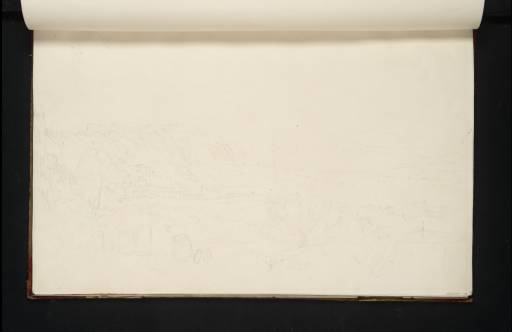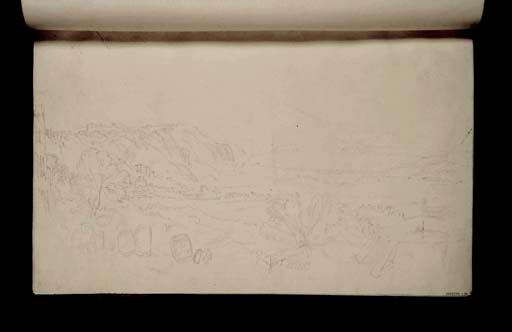Joseph Mallord William Turner View of the Bay of Pozzuoli with the Islands of Nisida and Ischia 1819
Image 1 of 2
Joseph Mallord William Turner,
View of the Bay of Pozzuoli with the Islands of Nisida and Ischia
1819
Joseph Mallord William Turner 1775–1851
Folio 15 Recto:
View of the Bay of Pozzuoli with the Islands of Nisida and Ischia 1819
D16103
Turner Bequest CLXXXVII 15
Turner Bequest CLXXXVII 15
Pencil on white wove paper, 255 x 403 mm
Inscribed by the artist in pencil ‘Vines’ within sketch above barrel, bottom left
Inscribed by John Ruskin in blue ink ‘15’ bottom right, descending right-hand edge
Stamped in black ‘CLXXXVII 15’ bottom right
Inscribed by the artist in pencil ‘Vines’ within sketch above barrel, bottom left
Inscribed by John Ruskin in blue ink ‘15’ bottom right, descending right-hand edge
Stamped in black ‘CLXXXVII 15’ bottom right
Accepted by the nation as part of the Turner Bequest 1856
Exhibition history
1904
[Associated with Third Loan Collection], possibly introduced as replacement items at Royal College of Art, London, between 1904–1909.
References
1909
A.J. Finberg, A Complete Inventory of the Drawings of the Turner Bequest, London 1909, vol.I, p.555, as ‘Bay of Baiæ. Third Loan collection, No.49’.
1991
Ian Warrell, ‘R.N. Wornum and the First Three Loan Collections: A History of the Early Display of the Turner Bequest Outside London’, Turner Studies, vol.11, no.1, Summer 1991, p.49, no.49.
Turner’s sojourn in Naples included extensive exploration of the Campi Flegrei (Phlegraean or Burning Fields), the area to the west of the city famous for its picturesque volcanic landscape and important classical sites. The subject of this drawing is a view of the Bay of Pozzuoli with the promontory known as the Scuola di Virgilio (present-day Parco Virgiliano) and the island of Nisida on the left, sweeping round to the Capo Miseno and the islands of Procida and the larger Ischia on the right. Turner’s viewpoint appears to be looking south-west across the plain and town of Bagnoli which he could have reached from one of two Roman tunnels through the Posillipo Hill, the Grotto of Posillipo or the nearby Grotto of Seiano. Today the district is heavily built up and industrialised but during the early nineteenth century it was still unspoiled verdant countryside, described by the travel writer John Chetwode Eustace as ‘truly Elysian’.1 Eustace documented that the road emerged from the western end of the Grotto of Posillipo and ran through the valley directly to the sea via ‘groves of poplars and mulberry-trees, united by vines interwoven in thick clustering garlands, suspended over rich harvests of wheat and maize all waving to the sea breeze.’2 Turner has noted the presence of ‘vines’ amidst the landscape as it gently slopes down towards the sea.
The artist appears to have derived this composition from a related sketch in the Gandolfo to Naples sketchbook (Tate D15667; Turner Bequest CLXXXIV 55a, top). In addition to mirroring the same topographical prospect he has incorporated a number of foreground details hinted at in the rougher study, such as the barrels and bottles in the bottom left-hand corner of this scene which match a written inscription regarding ‘wine filled casks’ on the other. Furthermore, the round structure in the bottom right-hand corner is also faintly outlined in the corresponding sketch and annotated with the word ‘Fire’, suggesting that this is some kind of outdoor stove or furnace used in the wine-making or cooperage process. It was often Turner’s practice to use elements of human interest to enliven his finished topographical paintings and it seems likely therefore that he deliberately worked up this subject as a potential candidate for future completion in watercolour. A variant rendering of a similar view can be found on folio 17 (D16105), and further related sketches can be seen in the Gandolfo to Naples sketchbook (Tate D15668; Turner Bequest CLXXXIV 56) and in the Naples, Paestum, Rome sketchbook (Tate D16042–D16045; Turner Bequest CLXXXVI 67a–69) suggesting that he visited the Bay of Pozzuoli on more than one occasion.
Technical notes:
The study is one of a number of items associated with the Third Loan Collection, a group of Turner Bequest works exhibited in the provinces during the late nineteenth and early twentieth centuries.1 Many of the loans suffered fading and damage from the effects of over-exposure during this time and this drawing seems to have been part of a replacement selection introduced between 1904 and 1909.2 Evidence of the discoloration of the paper is visible around the edges where the sheet has previously been displayed within a mount.
Verso:
Blank, save for inscription by an unknown hand in pencil ‘[?M]’ bottom right, ascending right-hand edge.
Nicola Moorby
May 2010
How to cite
Nicola Moorby, ‘View of the Bay of Pozzuoli with the Islands of Nisida and Ischia 1819 by Joseph Mallord William Turner’, catalogue entry, May 2010, in David Blayney Brown (ed.), J.M.W. Turner: Sketchbooks, Drawings and Watercolours, Tate Research Publication, December 2012, https://www


